Study on the Construction Method and Effects of Ipsilateral, Multi-Nozzle, High-Pressure Jet Grouting Cut-Off Wall
Abstract
:1. Introduction
2. Construction Method and Process
2.1. Device Characteristics
2.2. Construction Procedure
- (1)
- Preparation before construction
- (2)
- Wall axis measurement and setting out
- (3)
- Excavation of slurry guide groove
- (4)
- Hole location setting out
- (5)
- Layout of backstage pulping system
- (6)
- High-pressure fluid pipeline connection
- (7)
- Slurry preparation
- (8)
- Drill hole
- (9)
- Slurry transportation, gas transportation, static injection and lift injection
- (10)
- Lift the nozzle to the design elevation, stop jetting, and move it to the next hole.
- (11)
- Consolidate into a wall
3. Quality Inspection Method of Cut-Off Wall
3.1. Water Permeability Test
3.2. High-Density Electrical Method
4. Quality Inspection in Jinggangshan Navigation Hydropower Project
4.1. Project Overview
4.2. Wall Body Inspection Test
4.3. Detection of Wall Permeability
5. Quality Inspection in Xingan Navigation Hydropower Project
5.1. Project Overview
5.2. Detection of Wall Permeability
6. Conclusions
- (1)
- According to the construction characteristics of the embankment cut-off wall in hydraulic engineering, this study presents the transformation of the conventional high-pressure jet grouting machine, puts forward high-pressure jet grouting with a large-borehole-diameter, ipsilateral multi-nozzle, and puts forward the corresponding construction process based on this. The proposed construction method can adapt to the formation conditions in which it is difficult to implement conventional high-pressure jet grouting, and obtain good construction efficiency.
- (2)
- The construction method of high-pressure jet grouting with a large drill diameter and ipsilateral multi-nozzle is adopted to carry out field construction tests and for application in the cut-off wall of the reservoir area dyke protection works of the Jinggangshan navigation hydropower project and Xingan navigation hydropower project. Through penetration tests of core samples from a test wall, the side of core samples is smooth and the bonding is good, and the average permeability coefficient is less than the design value of impermeability. The permeability of the test wall section is detected by a high-density electrical meter, and there is no obvious leakage area in the wall. It indicates that a favorable wall quality can be obtained by using more efficient large-diameter and ipsilateral multi-nozzle jet grouting in the construction of high-pressure jet cut-off wall.
Author Contributions
Funding
Institutional Review Board Statement
Informed Consent Statement
Data Availability Statement
Acknowledgments
Conflicts of Interest
References
- Shepherd, D.A.; Kotan, E.; Dehn, F. Plastic concrete for cut-off walls: A review. Constr. Build. Mater. 2020, 255, 119248. [Google Scholar] [CrossRef]
- Cao, C.; Shi, C.; Lei, M.A. Simplified Approach to Design Jet-Grouted Bottom Sealing Barriers for Deep Excavations in Deep Aquifers. Appl. Sci. 2019, 9, 2307. [Google Scholar] [CrossRef] [Green Version]
- Zhang, Q.; Li, L.; Mo, Y. Grouting Technique Applications during Housing Construction. Appl. Mech. Mater. 2015, 724, 53–56. [Google Scholar] [CrossRef]
- Pelizza, S.; Peila, D. Soil and rock reinforcements in tunnelling. Tunn. Undergr. Space Technol. 1993, 8, 357–372. [Google Scholar] [CrossRef]
- Wu, Y.; Shen, S.; Yin, Z.; Xu, Y.-S. Characteristics of groundwater seepage with cut-off wall in gravel aquifer. II: Numerical analysis. Can. Geotech. J. 2015, 52, 1539–1549. [Google Scholar] [CrossRef]
- Manne, A.; Prasad, P.; Annam, M.K. Application of Jet Grouting for Geotechnical Challenges; Springer: Singapore, 2020. [Google Scholar]
- Barbu, C.; Sabău, A.-D.; Manoli, D.-M.; Șerbulea, M.-S. Water/Cement/Bentonite Ratio Selection Method for Artificial Groundwater Barriers Made of Cutoff Walls. Water 2022, 14, 376. [Google Scholar] [CrossRef]
- Bestuzheva, A.S.; Anakhaev, K.K. Seepage through a Homogeneous Earth-Fill Dam with a Cut-Off Wall on a Permeable Foundation. Power Technol. Eng. 2020, 54, 147–153. [Google Scholar] [CrossRef]
- Coomber, D.B. Groundwater control by jet grouting. Geol. Soc. Lond. Eng. Geol. Spec. Publ. 1986, 3, 445–454. [Google Scholar] [CrossRef]
- Dai, W.; Liang, L.; Zhang, B. Firefly Optimization Algorithm for the Prediction of Uplift due to High-Pressure Jet Grouting. Adv. Civ. Eng. 2020, 2020, 8833784. [Google Scholar] [CrossRef]
- Njock, P.G.A.; Chen, J.; Modoni, G.; Arulrajahl, A. A review of jet grouting practice and development. Arab. J. Geosci. 2018, 11, 459. [Google Scholar] [CrossRef]
- Li, Z.; Lv, J.; Xie, X.; Fu, H.; Huang, J.; Li, Z. Mechanical Characteristics of Structures and Ground Deformation Caused by Shield Tunneling Under-Passing Highways in Complex Geological Conditions Based on the MJS Method. Appl. Sci. 2021, 11, 9323. [Google Scholar] [CrossRef]
- Dai, G.; Sheng, Y.; Pan, Y.; Shi, G.; Li, S. Application of a Bentonite Slurry Modified by Polyvinyl Alcohol in the Cutoff of a Landfill. Adv. Civ. Eng. 2020, 2020, 7409520. [Google Scholar] [CrossRef]
- Fan, R.; Yang, Y.; Liu, S. Impact of In Situ Soil in Soil-Bentonite Cutoff Wall Backfill on Compressibility and Hydraulic Conductivity. Adv. Civ. Eng. 2021, 2021, 9350604. [Google Scholar] [CrossRef]
- Dai, G.; Zhang, Z.; Shi, G.; Li, S.; Shi, W.; Li, X. Study on anti-seepage slurry of landfill site modified by sodium carboxymethyl cellulose. Int. J. Mod. Phys. B 2019, 33, 1950377. [Google Scholar] [CrossRef]
- Fang, H.; Zhang, H.; Xue, B.; Gao, J.; Li, Y.; Gao, X.; Tian, A. Coordination Characteristics Analysis of Deformation between Polymer Anti-Seepage Wall and Earth Dam under Traffic Load. Water 2022, 14, 1442. [Google Scholar] [CrossRef]
- Yuan, Y.; Shen, S.-L.; Wang, Z.-F.; Wu, H.-N. Automatic pressure-control equipment for horizontal jet-grouting. Autom. Constr. 2016, 69, 11–20. [Google Scholar] [CrossRef]
- Guo, C.; Chu, X.; Wang, F. The feasibility of non-water reaction polymer grouting technology application in seepage prevention for tailings reservoirs. Water Supply 2017, 18, 203–213. [Google Scholar] [CrossRef]
- Guo, C.; Sun, B.; Hu, D.; Wang, F.; Shi, M.; Li, X. A Field Experimental Study on the Diffusion Behavior of Expanding Polymer Grouting Material in Soil. Soil Mech. Found. Eng. 2019, 56, 171–177. [Google Scholar] [CrossRef]
- Stark, T.D.; Axtell, P.J.; Lewis, J.R.; Dillon, J.C.; Empson, W.B.; Topi, J.E.; Walberg, F.C. Soil Inclusions in Jet Grout Columns. DFI J.—J. Deep Found. Inst. 2009, 3, 33–44. [Google Scholar] [CrossRef]
- Akin, M.K. Experimental studies on the physico-mechanical properties of jet-grout columns in sandy and silty soils. J. Afr. Earth Sci. 2016, 116, 190–197. [Google Scholar] [CrossRef]
- Cao, B.; de Souza, L.R.; Al-Tabbaa, A. Organic Contaminant-Triggered Self-Healing Soil Mix Cut-Off Wall Materials Incorporating Oil Sorbents. Materials 2020, 13, 5802. [Google Scholar] [CrossRef] [PubMed]
- Cui, Z.D.; Zhang, Z.L.; Yuan, L.; Zhan, Z.X.; Zhang, W.K. Design of Underground Continuous Walls; Springer: Singapore, 2020; pp. 339–390. [Google Scholar]
- Mozafari, M.; Milanović, P.; Jamei, J. Water leakage problems at the Tangab Dam Reservoir (SW Iran), case study of the complexities of dams on karst. Bull. Eng. Geol. Environ. 2021, 80, 7989–8007. [Google Scholar] [CrossRef]
- Chen, S.; Gu, C.; Lin, C.; Wang, Y.; Hariri-Ardebili, M.A. Prediction, monitoring, and interpretation of dam leakage flow via adaptative kernel extreme learning machine. Measurement 2020, 166, 108161. [Google Scholar] [CrossRef]
- Wang, T.; Chen, J.; Li, P.; Yin, Y.; Shen, C. Natural tracing for concentrated leakage detection in a rockfill dam. Eng. Geol. 2019, 249, 1–12. [Google Scholar] [CrossRef]
- Pan, Y.; Liu, Y.; Chen, E.J. Probabilistic investigation on defective jet-grouted cut-off wall with random geometric imperfections. Géotechnique 2019, 69, 420–433. [Google Scholar] [CrossRef]
- Zhang, P.; Song, H.; Rui, K.; Li, J.; Wang, S. Effects of Soil Properties on the Performance of TRD Cut-Off Wall. Adv. Civ. Eng. 2019, 2019, 7098498. [Google Scholar] [CrossRef] [Green Version]
- Hasan, F.; Abuel-Naga, H.; Broadbridge, P.; Leong, E.-C. Series-parallel structure-oriented electrical conductivity model of saturated clays. Appl. Clay Sci. 2018, 162, 239–251. [Google Scholar] [CrossRef]
- Hasan, M.F.; Abuel-Naga, H.; Leong, E.C. A modified series-parallel electrical resistivity model of saturated sand/clay mixture. Eng. Geol. 2021, 290, 106193. [Google Scholar] [CrossRef]
- Liu, X.; Shen, J.; Yang, M.; Cai, G.; Liu, S. Subsurface characterization of a construction site in Nanjing, China using ERT and CPTU methods. Eng. Geol. 2022, 299, 106563. [Google Scholar] [CrossRef]
- Wang, H.; Lin, C.-P.; Mok, T.H.; Wu, P.-L.; Liu, H.-C. High-fidelity subsurface resistivity imaging incorporating borehole measurements for monitoring underground construction. Eng. Geol. 2022, 299, 106558. [Google Scholar] [CrossRef]
- Modoni, G.; Wanik, L.; Maria, C.M.; Salvatore, E.; Bzówka, J.; Shui-Long, S.; Daniele, V.; Pingue, L. Strength of sandy and clayey soils cemented with single and double fluid jet grouting. Soils Found. 2019, 59, 942–954. [Google Scholar] [CrossRef]
- Nikbakhtan, B.; Ahangari, K.; Rahmani, N. Estimation of jet grouting parameters in Shahriar dam, Iran. Min. Sci. Technol. 2010, 20, 472–477. [Google Scholar] [CrossRef]
- Fu, J.; Xu, Y.; Shi, Y. Development and Application of Non-Destructive Testing Instrument for Wall Impermeability Based on a Water Drenching Method. Symmetry 2022, 14, 987. [Google Scholar] [CrossRef]
- Zhang, S.; Xue, B.; Wang, J.; Gao, J.; Wang, C.; Li, W. Preliminary Study of Nondestructive Testing of the Polymer Cutoff Wall Based on Vibration Theory. Adv. Mater. Sci. Eng. 2021, 2021, 4444684. [Google Scholar] [CrossRef]
- Inazumi, S.; Shakya, S.; Komaki, T.; Nakanishi, Y. Numerical Analysis on Performance of the Middle-Pressure Jet Grouting Method for Ground Improvement. Geosciences 2021, 11, 313. [Google Scholar] [CrossRef]
- Wang, Z.-F.; Shen, S.-L.; Modoni, G.; Zhou, A. Excess pore water pressure caused by the installation of jet grouting columns in clay. Comput. Geotech. 2020, 125, 103667. [Google Scholar] [CrossRef]
- Lei, J.; Fang, H.; Xue, B.; Li, Y. A Parallel Conformal Symplectic Euler Algorithm for GPR Numerical Simulation on Dispersive Media. IEEE Geosci. Remote Sens. Lett. 2021, 19, 1–5. [Google Scholar] [CrossRef]
- Wang, K.; Li, Z.; Zheng, H.; Xu, X.; He, H. A theoretical model for estimating the water-tightness of jet-grouted cut-off walls with geometric imperfections. Comput. Geotech. 2021, 138, 104316. [Google Scholar] [CrossRef]
- Flanagan, R.F.; Pepe, F.J. Jet Grouting for a Groundwater Cutoff Wall in Difficult Glacial Soil Deposits; US Department of Energy (USDOE): Washington, DC, USA, 1997.


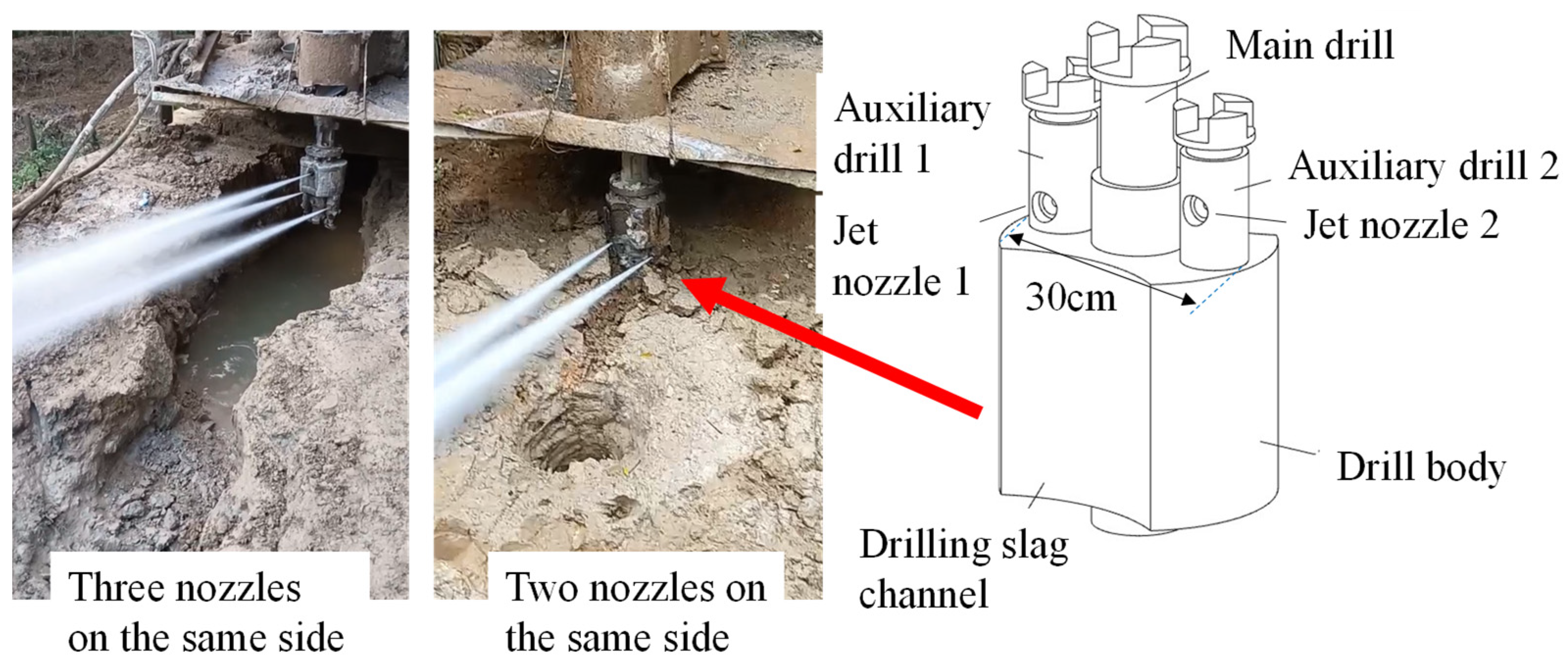
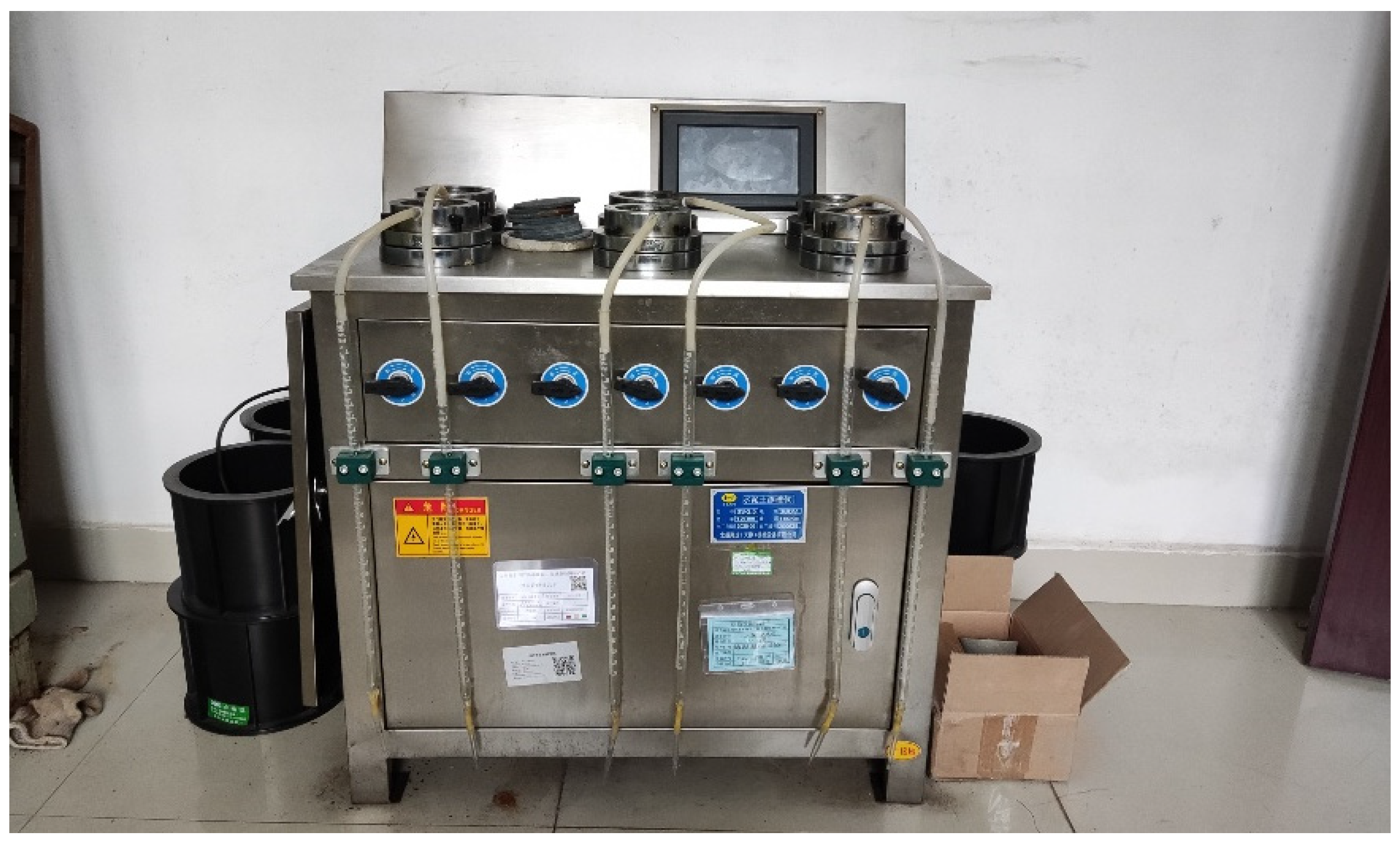
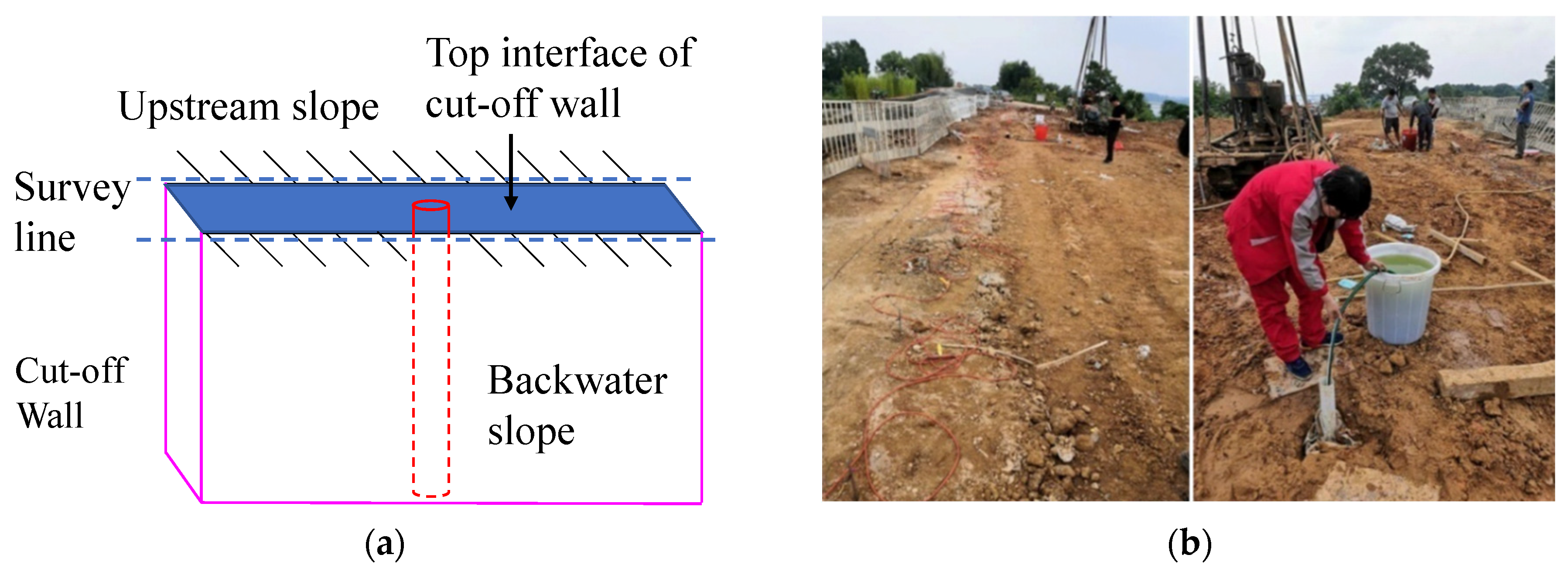

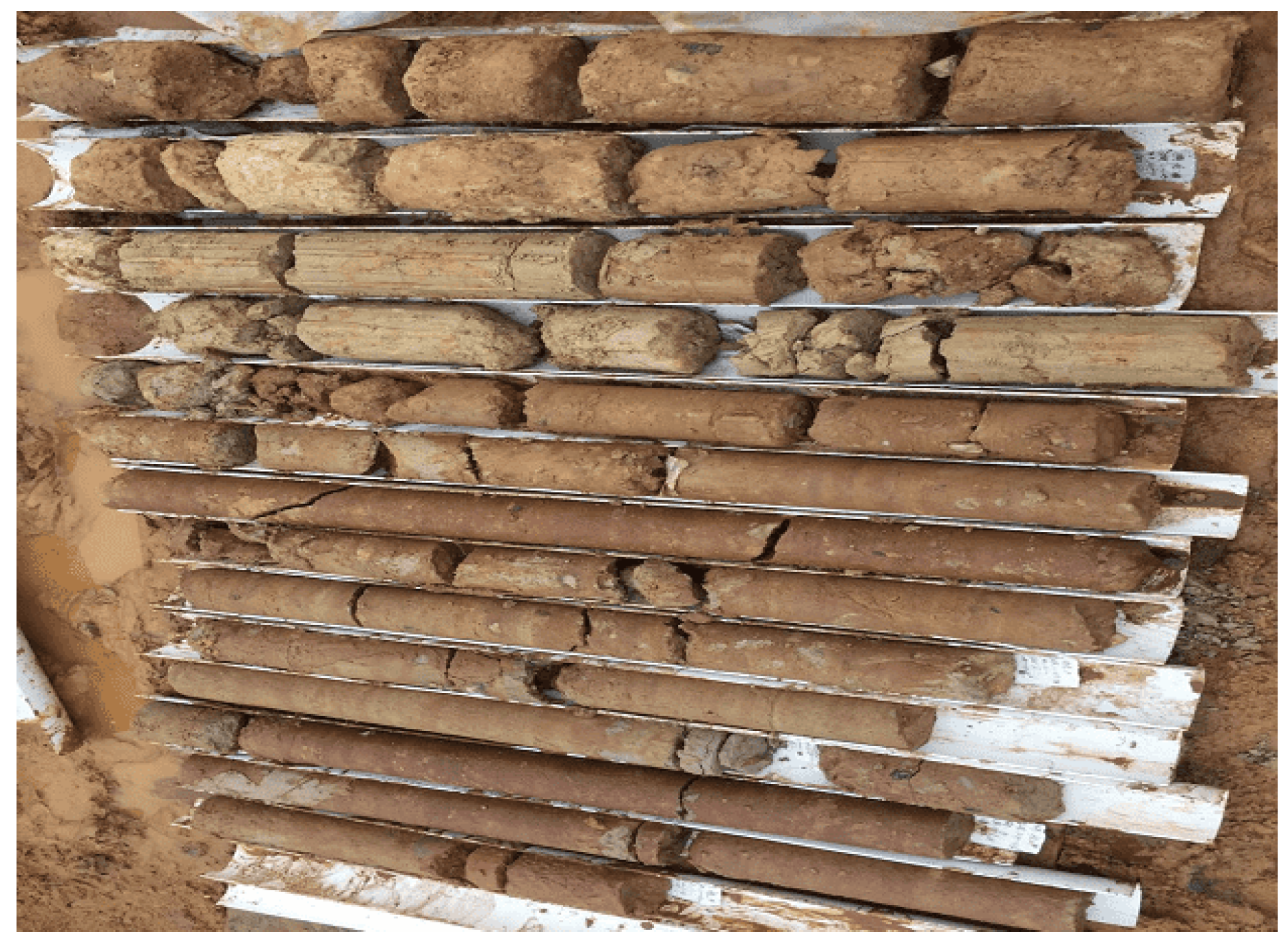
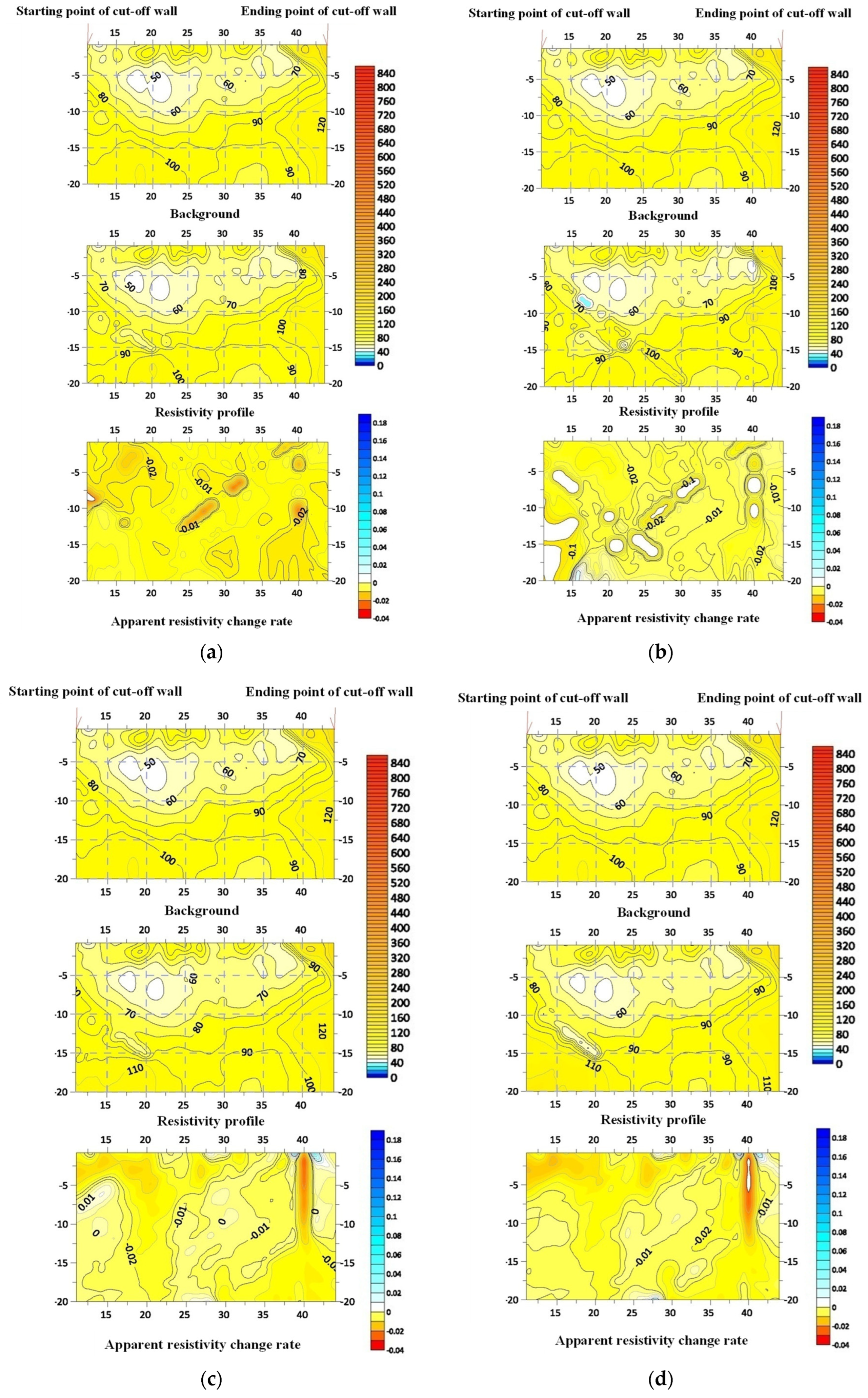


| Sample | Number | Sampling Location | Hydraulic Pressure/MPa | Condition after Water Pressure | Average Permeability Coefficient/cm/s | Impermeability Design Value/cm/s |
|---|---|---|---|---|---|---|
| Cement soil core 1 | 1-1 | Inspection point of high-pressure jet grouting cut-off wall | 0.08 | 6.12 × 10−7 | 6.92 × 10−7 | ≤i × 10−6 |
| 1-2 | 2.15 × 10−7 | |||||
| 1-3 | 6.92 × 10−7 | |||||
| 1-4 | 9.95 × 10−7 | |||||
| 1-5 | 8.10 × 10−7 | |||||
| 1-6 | 8.28 × 10−7 | |||||
| Cement soil core 2 | 2-1 | 3.56 × 10−7 | 7.35 × 10−7 | ≤i × 10−6 | ||
| 2-2 | 8.77 × 10−7 | |||||
| 2-3 | 7.35 × 10−7 | |||||
| 2-4 | 8.30 × 10−7 | |||||
| 2-5 | 6.52 × 10−7 | |||||
| 2-6 | 9.60 × 10−7 |
Publisher’s Note: MDPI stays neutral with regard to jurisdictional claims in published maps and institutional affiliations. |
© 2022 by the authors. Licensee MDPI, Basel, Switzerland. This article is an open access article distributed under the terms and conditions of the Creative Commons Attribution (CC BY) license (https://creativecommons.org/licenses/by/4.0/).
Share and Cite
Liu, D.; Xie, W.; Gao, J.; Hu, S.; Chen, M.; Li, Y.; Li, L. Study on the Construction Method and Effects of Ipsilateral, Multi-Nozzle, High-Pressure Jet Grouting Cut-Off Wall. Sustainability 2022, 14, 10383. https://doi.org/10.3390/su141610383
Liu D, Xie W, Gao J, Hu S, Chen M, Li Y, Li L. Study on the Construction Method and Effects of Ipsilateral, Multi-Nozzle, High-Pressure Jet Grouting Cut-Off Wall. Sustainability. 2022; 14(16):10383. https://doi.org/10.3390/su141610383
Chicago/Turabian StyleLiu, Da, Weijiang Xie, Jianglin Gao, Songtao Hu, Ming Chen, Yan Li, and Linhua Li. 2022. "Study on the Construction Method and Effects of Ipsilateral, Multi-Nozzle, High-Pressure Jet Grouting Cut-Off Wall" Sustainability 14, no. 16: 10383. https://doi.org/10.3390/su141610383
APA StyleLiu, D., Xie, W., Gao, J., Hu, S., Chen, M., Li, Y., & Li, L. (2022). Study on the Construction Method and Effects of Ipsilateral, Multi-Nozzle, High-Pressure Jet Grouting Cut-Off Wall. Sustainability, 14(16), 10383. https://doi.org/10.3390/su141610383






